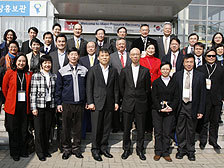
Seoul sojourn:
Secretary for the Environment KS Wong (front row, third right) visits the Mapo Resource Recovery Plant in Korea.
Seoul sojourn:
Secretary for the Environment KS Wong (front row, third right) visits the Mapo Resource Recovery Plant in Korea.
KS Wong sees Korean waste facilities
April 03, 2013
Secretary for the Environment KS Wong started his visit to Seoul today by inspecting local recycling and waste-to-energy facilities.
He learned about the implementation of the waste charging system there to see how Hong Kong can gain from Korean experience when charting its environmental policies.
Mr Wong first visited the Songpa recycling centre, which treats up to 450 tonnes of food waste per day using an anaerobic digestion process.
A food waste recycling programme has been implemented in Korea since 1998. Mr Wong said he was impressed by the effectiveness of the facility and believed Hong Kong could learn from Korea's experience.
He then toured the Mapo Resource Recovery Plant to learn about the development of waste treatment technology. The waste-to-energy plant is able to treat municipal solid waste through incineration, and generates electricity during the process.
In the afternoon, Mr Wong visited the residential and commercial areas of Geumcheon-gu to understand the operation of Korea’s nationwide volume-based waste charging system and food waste recycling programme.
Implemented in 1995, the waste charging system has successfully reduced municipal solid waste generation and increased the recycling rate in the country. Under the system, residents are required to dispose of trash in pre-paid garbage bags.
Mr Wong noted the Korean charging system, coupled with education, publicity and stringent measures against unauthorised dumping, comprehensively and effectively boosted waste separation and reduction at source, and the result is remarkable.
He will visit other waste recycling and treatment facilities in Seoul tomorrow.